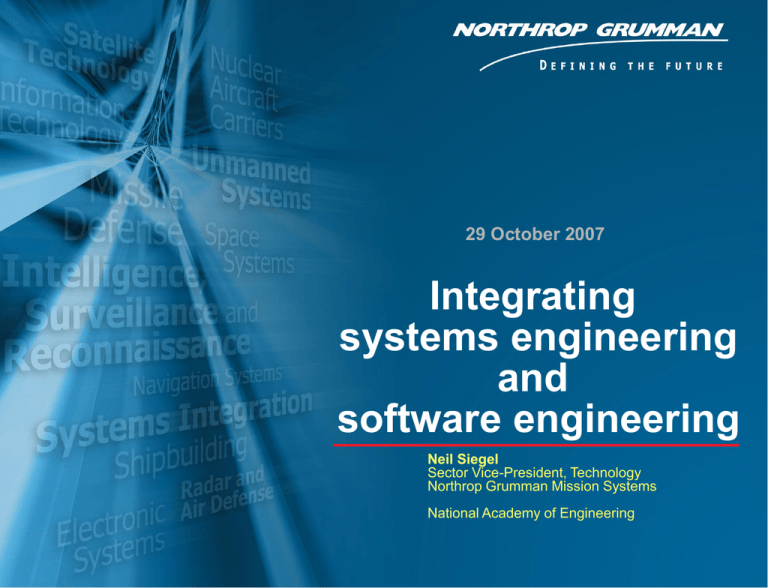Integrating systems engineering and software engineering
advertisement

29 October 2007 Integrating systems engineering and software engineering Neil Siegel Sector Vice-President, Technology Northrop Grumman Mission Systems National Academy of Engineering 1 Contents 4 observations about integrating systems engineering and software engineering 2 1. Integration through the development model Traditional 1994 revision Requirements System System requirements System requirements S/W requirements H/W requirements System design & validation Element Design System design S/W design H/W design S/W requirements H/W requirements S/W design H/W design The “1994” revision seems to lead to: (a) better software / hardware trade-offs (b) smaller software implementations 3 2. Nature of the system requirements Traditional approach: Both systems and software requirements are primarily functional requirements My lesson-learned: Users often relate poorly to functional requirements Resulting in lots of misunderstandings, misinterpretations A sign of a flaw: a system can meet all of the requirements, yet still be deemed neither effective nor suitable Users seem to relate better to representations of their desired business logic, e.g., “long mission threads” So, make the system requirements consist of those Plus: performance / capacity / port-to-port timing / reliability 4 3. Using operational measures to guide design We tend to want to predict and measure the technical performance of our designs We do this because our engineers often lack the domain knowledge create a mapping from operational parameters to technical parameters We can’t run from this problem – we need to bring in the necessary domain knowledge to close this loop Ideally, every design decision is driven by an assessment of its impact on operational performance and costs. We normally skip too many steps, and depend on intuition that improved technical performance results in improved operational performance. There are too many counter-examples for that to remain a viable assumption. 5 4. A key systems engineering goal – often neglected Achieving reliability in software We have long understood that simplicity is a hallmark of good hardware design Data indicates that this is true in software, too Yet, we let software designs get very complicated, probably because we do not treat designing for reliability in our software as a top-tier objective Good systems engineering can bound the scope of the software effort, enabling the requirements to be met with simpler designs This may be a key tool towards reducing the software-induced explosion of cost and schedule breaches 6 Summary Have the system design and validation activity precede software requirements analysis State the system requirements in representations that the operational users can understand Use operational measures (not just technical measures) to guide design Recognize that software reliability is a front-tier issue, and task systems engineering to help 7

